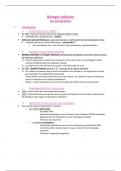Procaryotes Study guides, Class notes & Summaries
Looking for the best study guides, study notes and summaries about Procaryotes? On this page you'll find 34 study documents about Procaryotes.
Page 2 out of 34 results
Sort by
Synthèse sur les cellules procaryotes en profondeur

-
Micro Bio 120 Exam 1 Questions with Correct Answers 100% Solved
- Exam (elaborations) • 41 pages • 2024
-
- $10.29
- + learn more
Micro Bio 120 Exam 1 Questions with Correct Answers 100% Solved True or False: The plasma membrane and most other membranes are composed of a lipid bi-layer in which integral proteins are buried. True True or False: Procaryotic cells are usually smaller than eucaryotic cells. True True or False: Most procaryotes have strong cell walls that give them shape. True The significance of the plasma membrane is that: A) It selectively allows some molecules to pass into the organism ...

-
Micro Bio 120 Exam 1 Questions with Correct Answers 100% Solved
- Exam (elaborations) • 41 pages • 2024
-
- $14.99
- + learn more
Micro Bio 120 Exam 1 Questions with Correct Answers 100% Solved True or False: The plasma membrane and most other membranes are composed of a lipid bi-layer in which integral proteins are buried. True True or False: Procaryotic cells are usually smaller than eucaryotic cells. True True or False: Most procaryotes have strong cell walls that give them shape. True The significance of the plasma membrane is that: A) It selectively allows some molecules to pass into the organism B) It pr...
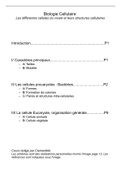
-
Découverte et description des cellules du vivant.
- Summary • 13 pages • 2021
-
- $8.25
- 1x sold
- + learn more
Ce cours est un résumé des connaissances nécessaires en Biologie Cellulaire à la fin de la L1/début L2. On y retrouve la description des cellules procaryotes et eucaryotes (structures, mobilité...).
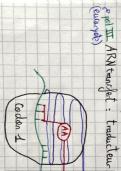
-
Génome et Expression eucaryote et procaryote
- Summary • 7 pages • 2024
-
- $9.53
- + learn more
Vous trouverez un résumé avec des schémas sur la réplication, la transcription et la traduction eucaryote et procaryote de l'ADN. Les 3 types d'ARN sont présentés ainsi que leurs rôles, l'organisation dynamique de l'ADN (structure et composition), la réplication semi-conservative détaillée, la transcription de l'ADN à l'ARN (initiation, déroulement et terminaison), traduction de l'ARN avec le code génétique, les 3 phases de la traduction chez les procaryotes et enfin la t...
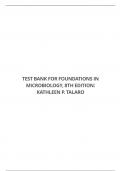
-
TEST BANK FOR FOUNDATIONS IN MICROBIOLOGY, 8TH EDITION: KATHLEEN P. TALARO
- Exam (elaborations) • 14 pages • 2023
-
- $10.00
- + learn more
Chapter 01 Testbank Student: ___________________________________________________________________________ 1. Disease-causing microorganisms are called A. decomposers. B. procaryotes. C. pathogens. D. eucaryotes. E. fermenters. 2. The microorganisms that recycle nutrients by breaking down dead matter and wastes are called A. decomposers. B. prokaryotes. C. pathogens. D. eukaryotes. E. fermenters. 3. The microorganisms that do not have a nucleus in their cells are called A. decompose...
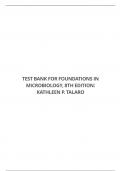
-
TEST BANK FOR FOUNDATIONS IN MICROBIOLOGY, 8TH EDITION: KATHLEEN P. TALARO
- Exam (elaborations) • 14 pages • 2023
-
- $10.00
- + learn more
Chapter 01 Testbank Student: ___________________________________________________________________________ 1. Disease-causing microorganisms are called A. decomposers. B. procaryotes. C. pathogens. D. eucaryotes. E. fermenters. 2. The microorganisms that recycle nutrients by breaking down dead matter and wastes are called A. decomposers. B. prokaryotes. C. pathogens. D. eukaryotes. E. fermenters. 3. The microorganisms that do not have a nucleus in their cells are called A. decompose...
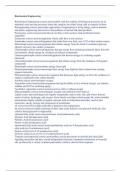
-
Biochemical Engineering
- Exam (elaborations) • 7 pages • 2023
-
- $15.99
- + learn more
Biochemical Engineering correct answersdeals with the conduct of biological processes on an industrial scale and the processes where the catalysts are either living cells or extracts of them Bioengineering correct answersthe application of engineering to living things, such as humans and plants. engineering that involves biosynthesis of animal and plant products Procaryotes correct answerscells that do not have a true nucleus; lack membrane bound organelles Eucaryotes correct answersorganisms...
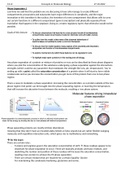
-
Phase Separation 2
- Class notes • 9 pages • 2022
-
- $9.24
- + learn more
Last time we said that the problem we are discussing is how cells manage to create different compartments; procaryotes and eukaryotes have major differences in complexity, and the major innovation in this transition is the nucleus, the invention of a new compartment that allows cells to carry out certain functions in a different compartment (gene transcription) and physically separated from translation that happens in the cytoplasm. Doing so, creates regulatory layers that otherwise would not be...
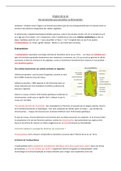
-
Des procaryotes aux eucaryotes: la Deuxième genèse
- Class notes • 4 pages • 2021
- Available in package deal
-
- $4.94
- + learn more
L’endosymbiose est la coopération mutuellement bénéfique entre deux organismes vivants, donc une forme de symbiose, où l'un est contenu par l'autre.

Did you know that on average a seller on Stuvia earns $82 per month selling study resources? Hmm, hint, hint. Discover all about earning on Stuvia

